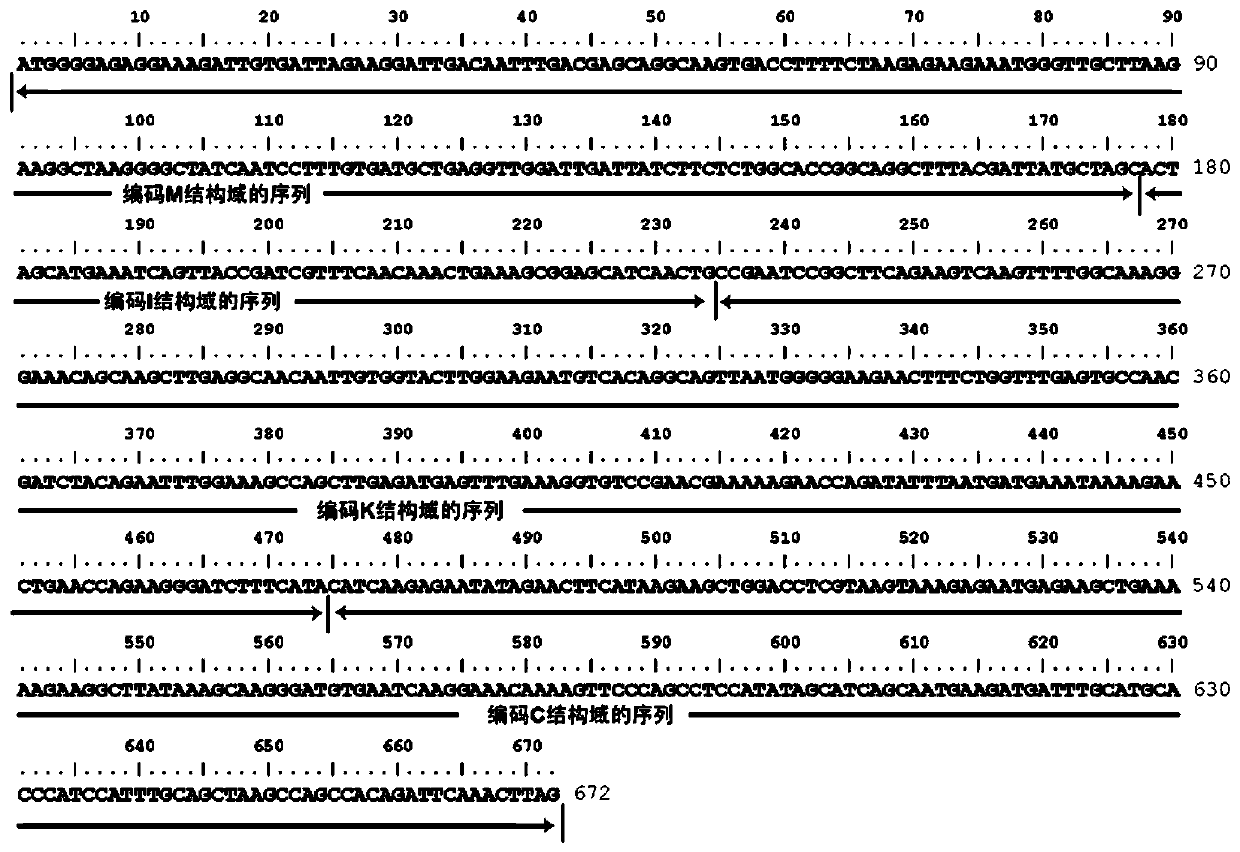EjAGL17 protein for regulating and controlling eriobotrya japonica flowering time as well as coding gene and application of gene
A technology of loquat and protein, applied in the fields of application, genetic engineering, plant genetic improvement, etc., can solve the problem that the flowering time has not been reported, and achieve the effect of promoting early flowering, good application prospects, and promoting early fruiting
- Summary
- Abstract
- Description
- Claims
- Application Information
AI Technical Summary
Problems solved by technology
Method used
Image
Examples
Embodiment 1
[0022] Cloning of embodiment 1 loquat EjAGL17 gene cDNA sequence
[0023] Extraction of Total RNA from Loquat Flower Buds
[0024] The flower buds of the loquat differentiation stage with a fresh length of about 1.0 cm were collected, quickly put into cryopreservation tubes, put into liquid nitrogen for quick freezing for 2 hours, and then put into -80°C ultra-low temperature freezer for later use. Use the RNA extraction kit to extract the total RNA of loquat flower buds: take out the collected flower buds from the -80°C ultra-low temperature freezer, put them into a pre-frozen mortar with 1 mL RLT lysate and 100 μL PLAN Taid, and grind them thoroughly at room temperature ;Transfer the above grinding solution to a 1.5mL eppendorf centrifuge tube, centrifuge at 13000rpm for 10min, absorb 500μL supernatant, and transfer to a new 1.5mL centrifuge tube; add 250μL absolute alcohol to the supernatant, and mix well by pipetting , put it into the adsorption column, then put the adsor...
Embodiment 2
[0035] Example 2 Analysis of subcellular localization of loquat EjAGL17 gene
[0036] The ORF sequence of the EjAGL17 gene was analyzed using the software Oligo7, and primers for the restriction sites at both ends were designed. EjAGL17-SacI: 5'-cgagctcATGGGGAGAGGAAAGATTGTGAT-3'; The pMD18-EjAGL17 plasmid with correct sequencing was used as a template to amplify, and the ORF sequence of the EjAGL17 gene containing SacI and BamHI restriction sites was obtained. The target gene and the transformed vector pCAMBIA1300 plasmid were respectively extracted, and double-digested with restriction endonucleases SacI and BamHI respectively, and recovered after agarose gel electrophoresis. Use T 4 DNA ligase connects the target gene EjAGL17 after double digestion with the modified pCAMBIA1300 vector, and transfers the recombinant vector into Escherichia coli competent cells, and then performs bacterial liquid PCR and double digestion verification before sequencing to ensure that the targ...
Embodiment 3
[0039] Example 3 Real-time fluorescent quantitative PCR expression analysis of loquat EjAGL17 gene
[0040] The flowering process of loquat includes: (A) Physiological differentiation period of flower buds, (B) Morphological differentiation period of flower buds, (C) Main axis differentiation period of inflorescence, (D) Branch axis differentiation stage of inflorescence, (E) Rapid growth of lateral branches of inflorescence Elongation stage, (F) floret differentiation stage, (G) flower bud dew stage, (H) full flower stage and (I) flower fade stage. The total RNA of the nine developmental stages of loquat was extracted respectively, and after removing the trace amount of DNA in the total RNA, it was reverse transcribed into cDNA. Based on loquat cDNA as a template, oligo 6.0 software was used to design real-time fluorescent quantitative PCR primers qRTEjAGL17F:5'-TTGACGAGCAGGCAAGTGAC-3' and qRTEjAGL17R:5'-TAGCATAATCGTAAAGCCTG-3'. The loquat actin gene was used as an internal ...
PUM
 Login to View More
Login to View More Abstract
Description
Claims
Application Information
 Login to View More
Login to View More - R&D
- Intellectual Property
- Life Sciences
- Materials
- Tech Scout
- Unparalleled Data Quality
- Higher Quality Content
- 60% Fewer Hallucinations
Browse by: Latest US Patents, China's latest patents, Technical Efficacy Thesaurus, Application Domain, Technology Topic, Popular Technical Reports.
© 2025 PatSnap. All rights reserved.Legal|Privacy policy|Modern Slavery Act Transparency Statement|Sitemap|About US| Contact US: help@patsnap.com



